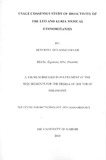| dc.description.abstract | Traditional medicines are useful for managing human and animal health in Kenya.
The purpose of this study was to document, compare and investigate the bioactivity of Luo
and Kuria ethnopharmacopoeias.
The findings on ethnobotany and ethnomedicine are based upon fieldwork in
Kuria, Migori, Siaya and Kisumu districts, in Nyanza province Kenya. Thirty four
consenting traditional practitioners were interviewed over a one and a half year period on
aspects of ethnosystematics, ethnomedicine, ethnobotany and ethnopharmacology. The
cross-sectional survey used botanical collections, group discussions, interviews and
questionnaires. Selection of species for biological activity testing was based on the
consistency of use in the two ethnic communities. Biological activity studies used
qualitative (disc diffusion) and quantitative (minimum inhibitory concentration tests, LC50
and IC50) tests.
The study gives a lexicon (plant and disease names) and taxonomy of illness and
diseases in the Luo and Kuria medical systems. Out of the 306 documented species, 158
species (135 genera) and 148 species (129 genera) were used by Luo and Kuria
respectively; 73 species and 38 families are common to both ethnopharmacopoeias. Of
these 28 species are used to treat similar diseases.
Based on richness of species and usefulness, the most important families for
illness/ disease conditions are Fabaceae, Asteraceae and Euphorbiaceae. Both
ethnopharmacopoeia have high species diversity indicated by high Shannon-Wiener
indices (H), 5.33 and 6.52 for the Luo and Kuria respectively. Based on their close
coefficient of similarity (S) value of 47.4
amilies, species and usage possibly due to cultural diffusion. The individual
informant consensus factor (Fic) values for the groups, 0.504 and 0.567 for Luo and Kuria,
indicate a medium level of informant agreement.
Traditional perceptions of health are prevalent and deeply rooted among the Kuria
and Luo. Forty two and 52 illness and disease conditions are documented for the Luo and
Kuria respectively. The top five ranked illness and disease conditions in terms of citation
frequency among the two groups were: stomachache, culture bound syndrome, cattle
diseases and infant diseases. Most plants have multiple disease uses. Leaf was the most
frequently utilized plant part in both ethnopharmacopoeia and decoctions and infusions
were the chief formulations. Out of the 308 medicinal plants species used by the Kuria and
Luo 55 (17.8%) are formulated in multi-plant preparations; the other 253 (82.2%) are
formulated as single plant preparations.
Fifteen plants with high and consistent usage reports among Luo and Kuria
traditional healers were selected, collected and then screened for antibacterial, antifungal,
and antiprotozoal activity with an overall aim of evaluating their use. In vitro bioactivity
screening (drug susceptibility tests) for antimicrobial (bacterial, protozoal and mycotic)
activities against Gram-positive and Gram-negative bacteria, yeasts and dermatophytes:
Staphylococcus aureus, Escherichia coli, Microsporum gypseum and Candida albicans
followed using methanolic extractions. Antimicrobial activity from the selected plant
species was demonstrated. Most plant extracts exhibited antimicrobial activity against one
or more of the tested microorganisms but no activity was shown for Escherichia coli. Of
the 15 plants tested 40% showed antibacterial and 27% antifungal activity. Methanolic
extracts were more active on gram-positive and filamentous fungi. T
cotic activity in dilutions ranging from 1: 2 to 1: 64. Albizia coriaria, Plectranthus
barbatus and Tithonia diversifolia inhibited all test microbes in the MIC tests.
Dichloromethane extracts of eight medicinal plants were screened against two
clones of Plasmodium falciparum, W2 (chloroquine resistant) and D6 (CQ sensitive) using
the SYBR® Green I assay. The screenings yielded moderate to high antiplasmodial
activity. Of the eight plants tested 37.5% showed activity (IC50 < 5μg/ml) against
Chloroquine resistant and 50% active (IC50 <5μg/ml) against Chloroquine sensitive
Plasmodium falciparum. Tylosema fassoglense, Ocimum kilimandscharicum and
Ageratum conyzoides exhibited high activity against W-2 and Ocimum gratissimum,
Ageratum conyzoides and Tylosema fassoglensis, Croton macrostachyus high activity
against D-6.
Ethanolic extracts of five plants were tested for Aedes aegypti larvicidal toxicity at
dilutions between 0.2% and 1.0%. Upon 24hours exposure Albizia coriaria and
Plectranthus barbatus extracts were found to have the most larvicidal activity.
In conclusion both cultures have rich ethnopharmacopoeias and extensive plant
knowledge. Even though accessibility to biomedicine has increased in the study areas
traditional medicine plays an important role in providing healthcare. Ethnobotanical
knowledge was sufficiently reliable for identifying plant extracts with antimicrobial
activity. Some species with significant antibacterial; antimycotic and antiprotozoal effects
were found in this study highlighting the significance of indigenous knowledge in seeking
plants with bioactive compounds likely to yield new drugs. | en |

